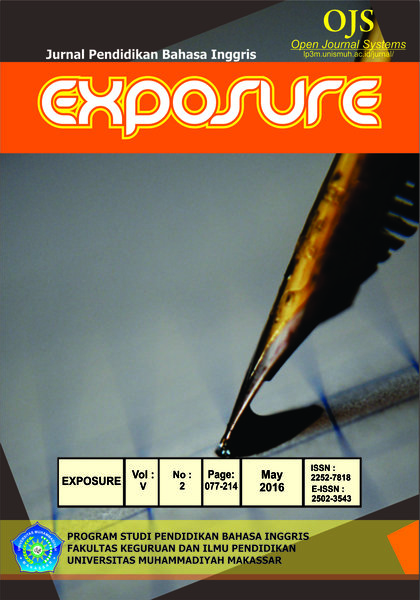USING THE “DASH” (DUPLICATED ANSWER SHEETS) METHOD IN IMPROVING STUDENTS’ READING COMPREHENSION
DOI:
https://doi.org/10.26618/exposure.v5i2.840Abstract
This study aims at finding out to what extent DASH method improves students’ reading comprehension and how good the students’ improvement regarding their reading comprehension after taught through DASH method. This study was conducted at SMAN 1 Tanete Rilau, Barru Regency. The study used pre-experimental design involving only one class to observe, out of two hundred-eighty population of eleventh-grade students of IPA-II classes at SMAN-1 Tanete Rilau in academic year 2014/2015. The technique sampling was cluster random sampling. The instruments of collecting data used in this study were multiple choice and essay which were used to measure the students’ comprehension in reading. Based on the data collected from the students showed that the post-test value is higher than pre-test table, so the null hypothesis is rejected. It means there is an influence of “DASH” (Duplicated Answer Sheets) method on student reading ability. So the students have responsibility and feel enjoy the learning process. It means that can “DASH” (Duplicated Answer Sheets) method be used as one of the alternatives to teach reading. Further study is suggested to conduct the investigation of other teaching method or strategy that can be applied by the teacher to encourage their student in reading comprehension.
Keywords: DASH Method, Reading Comprehension
References
Alderson, J. Charles. 2000. Assessing Reading. Cambridge, England: Cambridge University Press.
Anderson and Person. 1984. Teaching Reading. Third Edition: Boston: J. Estill Alexander.
Arikunto, Suharsimi. 2005. Prosedur Penelitian. (suatu pendekatan praktik, Edisi revisi IV). Jakarta: PT RINEKA CIPTA.
Arikunto, Suharsimi. 2010. Prosedur Penelitian. (suatu pendekatan praktik, Edisi revisi IV). Jakarta: PT RINEKA CIPTA.
Arsyad, Azhar. 1994. Dasar-Dasar Penguasaan Bahasa Inggris Lewat Your Basic Vocabulary. Makassar: Pustaka Pesantren UP.
Bahleuwi, Ajie. 2010. Instant Vocabulary. Yogyakarta: Kaysa Media.
Basri D, Muhammad. 2007. Fundamental of Research Methodology. Makassar.
Best, John. W. 1977. Research in Education. Third Edition: New Jersey: Prentice-Hall, Inc., Englewood Cliffs.
Bull, Victoria. 2008. Oxford Learner’s Pocket Dictionary. Fourth Edition: New York: Oxford University Press.
Carrillo, Lawrence. 1975. Teaching Reading. New York: St. Martin Press.
Echol, John M, and Shadily Hassan. 2005. Kamus Inggris Indonesia. Jakarta: Gramedia.
Elizabeth, et. All. 2000. Teaching Reading. Chicago: Chicago University Press.
Hamra Arifuddin & Syatriana Eny. 2010. Developing a Model of Teaching Reading Comprehension for EFL Students. TEFLIN Journal.
Kustaryo S. 1988. Reading Technique for College Students. Jakarta: P2 LPTK.
Lestary, Dhevie. 2011. Influence of Think-Pair-Share Technique on the Students’ Reading Ability at the Eighth Grade Students of SMP PGRI Batuceper Tangerang. Tangerang: Setia Budhi Rangkasbitung University.
Mahdalena, Leny. 2007. Effects of Pre-Questioning on the Reading Comprehension Achievement of the Second Grade Students at SMAN-2 Jekan Raya in Academic Year 2006/2007. Palangkaraya: Palangkaraya University.
Nilawati, Aulia. 2005. Improving reading comprehension by using Directed Activities Related to Text. Makassar.
Nunan David, Eggewn, Paul and Kauchack, Donald. 1989. Method for Teaching, a skill Approach. Ohio: Merril Publishing Company.
Nunan, David. 1991. Language Teaching Methodology. New York: Prentice Hall.
Shieh, Wenyuh & Freiermuth Mark R. 2010. Using the DASH Method to Measure Reading Comprehension. TESOL Quarterly.
Sugiyono. 2013. Cara Mudah Menyusun: Skripsi, Tesis, dan Disertasi, Bandung: ALFABETA.
Downloads
Published
Issue
Section
License
Authors who publish with this journal agree to the following terms:
In order to assure the highest standards for published articles, a peer review policy is applied. In pursue of the compliance with academic standards, all parties involved in the publishing process (the authors, the editors and the editorial board and the reviewers) agree to meet the responsibilities stated below in accordance to the Journal publication ethics and malpractice statement.
Duties of Authors:
- The author(s) warrant that the submitted article is an original work, which has not been previously published, and that they have obtained an agreement from any co-author(s) prior to the manuscript’s submission;
- The author(s) should not submit articles describing essentially the same research to more than one journal;
- The authors(s) make certain that the manuscript meets the terms of the Manuscript Submission Guideline regarding appropriate academic citation and that no copyright infringement occurs;
- The authors(s) should inform the editors about any conflict of interests and report any errors they subsequently, discover in their manuscript.
Duties of Editors and the Editorial Board:
- The editors, together with the editorial board, are responsible for deciding upon the publication or rejection of the submitted manuscripts based only on their originality, significance, and relevance to the domains of the journal;
- The editors evaluate the manuscripts compliance with academic criteria, the domains of the journal and the guidelines;
- The editors must at all times respect the confidentiality of any information pertaining to the submitted manuscripts;
- The editors assign the review of each manuscript to two reviewers chosen according to their domains of expertise. The editors must take into account any conflict of interest reported by the authors and the reviewers.
- The editors must ensure that the comments and recommendations of the reviewers are sent to the author(s) in due time and that the manuscripts are returned to the editors, who take the final decision to publish them or not.
Authors are permitted and encouraged to post online a pre-publication manuscript (but not the Publisher’s final formatted PDF version of the Work) in institutional repositories or on their Websites prior to and during the submission process, as it can lead to productive exchanges, as well as earlier and greater citation of published work (see The Effect of Open Access). Any such posting made before acceptance and publication of the Work shall be updated upon publication to include a reference to the Publisher-assigned DOI (Digital Object Identifier) and a link to the online abstract for the final published Work in the Journal.

